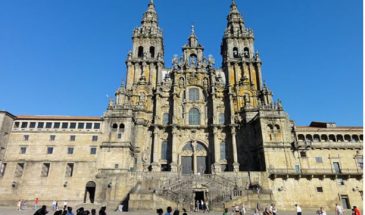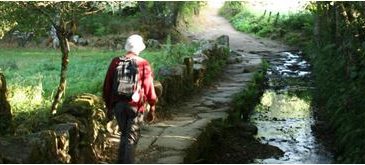- Overview
- Trip Outline
- Pricing
- Trip Includes
- Trip Excludes
- Gallery
- Reviews
- FAQ
Route:

Technical Characteristics:
Tour Profile: Hard. Longer distances and hilly terrain with sometimes as much as 30 kilometers per day requiring a maximum of 7.5 hours of walking.
Distance: 278 km
Travel Season: Daily arrival from April 1 to October 31, 2023
Accommodation:
Small hotels in the Camino itself of 2* and 3* standard. In Santiago two nights in centrally located small hotel.
This is not a standard walking tour. People from many countries across Europe have been travelling along the Camino de Santiago for centuries. The Camino itself is part of our history and cultural heritage. Out of all the long distance routes that exist, only the Camino de Santiago has been given the recognition of World Heritage by the United Nations because of its historical and spiritual significance. Countless millions have walked it over the last thousand years and yet it has remained largely unchanged. It continues to cross the same rivers, climb the same mountains and pass by the same villages, chapels, churches and cathedrals. You will be walking the last half of the classic Camino de Santiago. Starting in Leon where many pilgrims begin their walk will give you the chance to soak up the history that surrounds this long distance route.
Itineraries
Day 1
Arrival to Astorga
Under the streets of Astorga, archaeologists have found the remains of a Roman Capital where gold and silver from the nearby mountains was traded. The town hall building and its clock in Plaza de España are worth a look as it chimes on the hour. Don´t miss the Neogothic Episcopal Palace designed in 1889 by the famous Catalan architect Antonio Gaudí. The chapel of San Esteban and the baroque church of Santa Marta are often overshadowed by the impressive gothic cathedral of Astorga standing tall between them.
Day 2
Astorga - Rabanal Del Camino 21.4 km
Leave the plains of Castile behind and heading towards the mountains of Leon. This should be a relatively gentle first day walking. As you walk across this region known as the “Maragatería” of poor ocre soils and big stone houses you will come across several small villages where you can stop for coffee breaks and buy food. In Rabanal del Camino there is a small Benedictine monastery which invites pilgrims to sing Gregorian chants and pray.

Day 3
Rabanal Del Camino - Molinaseca 26.5 km
Today you head up to the highest point on the whole journey: the Foncebadon Mountain Pass at 1505 meters. The icon of the day is the Cross of Iron “Cruz de Ferro” where pilgrims have left stones as they pass for centuries. The way up can be steep in places but most people find the descent into Molinaseca more tiring as you will descend nearly 900 meters! You will enter the region of El Bierzo, a fertile and well-watered valley, with its own benign microclimate. Molinaseca is one of the most beautiful villages of the Camino.
Day 4
Molinaseca - Villafranca 30.7 km
Today you start by negotiating the rather chaotic city of Ponferrada which is the largest town you will come across before you reach Santiago. Later you will cross the flat valley of El Bierzo, famous for its fertile land: where vineyards are grown, and fruit trees such as apples, pears, cherries and chestnuts are in full blossom in spring time (beware hay fever sufferers!). Finally you will arrive at the seniorial and conventual old town of Villafranca, with palatial streets reminiscent of Genoa or Florence.
Day 5
Villafranca - Herrerias 23.5 km
More mountains are ahead of us but today we walk up the valley leading us towards Galicia to finish at the foot of the mountains. Tomorrow we will climb into Galicia so rest well.

Day 6
Herrerias - Triacastela 32.7 km
The climb into O´Cebreiro is often exaggerated, 7.5 kilometres of ascent can be very pleasant on a clear day as it offers wonderful views of the Bierzo to the south. At the top of the hill you will reach the magical village of O´Cebreiro, one of the highlights of the Camino. There are two smaller climbs after this (taking us up to 1335 meters) before descending into Triacastella. The landscape is changing as we enter the green mountainous region of Galicia. There will be plenty of ups and downs ahead but mountains as big as this we will not come across.
Day 7
Triacastela - Sarria 25 km
This is one of the most beautiful sections of the Camino. In Samos you can visit the great Benedictine Monastery. From Samos the Camino takes you through wooded areas crossing small villages, rivers in peace and quiet. You will reach the busy town of Sarria at the end of the day.
Day 8
Sarria - Portomarín 22.9 km
Initially you climb up steeply out of Sarria, through ancient oaks, birch trees and chestnut trees. You then walk through many hamlets dotted along areas of cultivated land, grazing pastures and woodlands, in the direction of Portomarín. The walking is done along quiet country lanes and natural pathways offering good shade from the sun or shelter from rain. Finally you descend steeply into Portomarín and cross the great river Miño on the banks of which you will see the remains of the old site of the village. You will find several cafes along the way to stop, rest and have something to eat or drink.

Day 9
Portomarín - Palas De Rei 26.1 km
There are several kilometres of road walking on this next stretch and the
first half of the stage is steadily uphill to the Sierra Ligonde. The Camino
criss-crosses the road travelling along tree lined lanes avoiding much of the road noise. There are pine forests, corn fields, meadows and oak and chestnut trees on this stretch of the Camino. You will also go through a number of small villages full of rural character and cross the rivers Ligonde and Portos, along the way. Towards the end of the walk, you are greeted by the scent of the eucalyptus trees. After climbing the Alto do Rosario, you will finally descend into Palas de Rei.
Day 10
Palas De Rei - Arzúa 29.5 km
Today we cross six river valleys and a glorious 70% is on pathways mostly though woodland that helps keep the noise of traffic down and energy levels up. Melide makes a good halfway stop where you can try its renowned octopus dishes “pulpo a la gallega” for lunch. We can recommend “Pulpería Ezequiel” on the main street, on the left hand side. Leave some energy for the final climb into Arzúa. This area is full of mediaeval castles, as well as Romanesque churches and settlements. In the early fourteenth century the area was quite dangerous for pilgrims: a nobleman called Álvaro Sánchez de Ulloa would attack them from the nearby castle of Felpós to demand unjust charges for the rights of passage, sometimes even resorting to violence. Don’t worry, he no longer lives here!
Day 11
Arzúa - Rua 17.2 km
This is a short stage. Two thirds of the day we walk on natural paths with good shade offered by the mixed woodland with pine, eucalyptus, birch, oak and chestnut trees. Amongst them are meadows and small orchards near the many small villages you go through. There are several steep climbs along the way, particularly leading up to the Alto de Santa Irene. In between we have a largely level path with just three shallow river valleys. The Camino now becomes busier with pilgrims as we near the fabled city of Santiago. Arzúa has two Romanesque churches. The main one, on the square, is dedicated to St James. It has a remarkable Baroque tower added in the fifteenth century.

Day 12
Rua - Santiago 22.6 km
The last stage. The first few kilometres are through dense eucalyptus forest. Enjoy the shade and peace they exude. As you approach the city, groups of pilgrims and asphalt roads take over. The long climb up to Monte Gozo can be particularly tiring. There are some very steep climbs along the way. Just when you think you are there, there is another hill to climb! Depending on the time of year and the day of the week, there could be big crowds as you approach. Enjoy the excitement of being part of it all! Passing through the outskirts of the city will be rewarded as you enter the historical centre. Follow the other pilgrims and the many signs to make your way towards the Cathedral. If the Cathedral is crowded, find a quiet church or square (there are many) to offer your thanks for your safe arrival and return early the next morning when the Cathedral is empty and quiet.

Day 13
Rest Day in Santiago de Compostela
World Heritage Site since 1985, the entire historic centre is a huge museum. We recommend you visit the tourist information center in Rua do Vilar and don´t miss a visit inside the Cathedral and enjoy the streets of this city full of history. The most important of the many places of interest in Santiago is the Cathedral, part Romanesque, part Baroque, with its magnificent Portico de la Gloria and façade giving on to the Plaza de Obradoiro. The Cathedral also houses what is the world’s biggest censer (incense burner), the famous “botafumeiro”. It is made of silver and it weighs nearly 80 kg, requiring a team of 8 men and a system of pulleys to set it in motion after mass, swinging at ceiling level from one end to the other.
Day 14
Departure
Individual departure or extra days

Prices
Included:
- 13 nights’ accommodation in a room with its own bathroom
- 13 breakfasts and 11 dinners (not last two nights in Santiago)
- Luggage transfers between hotels (one item of luggage per person up to 20 kg)
- Detailed maps with the trail clearly marked
- Itinerary description, full of recommendations for things to do and places to visit, advice and suggestions and important information about your accommodation
- Activity insurance
- Pilgrims Passport
- Emergency support
Not Included:
- Personal expenses
- Rest day in Sarria (if pre-booked in advance)
- Meals not included in itinerary
No Details Found













There are no reviews yet.